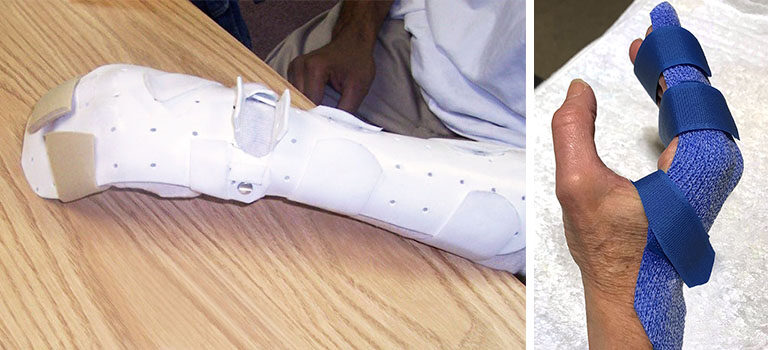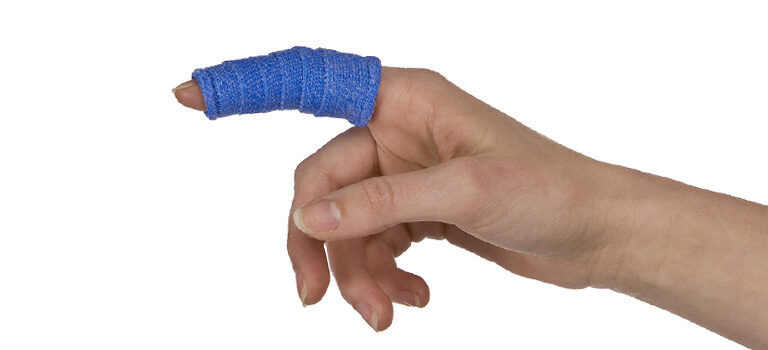
Counterforce Strap Orthoses for the Treatment of Tennis Elbow and Golfer’s Elbow
Pathology: Tennis Elbow
‘Tennis Elbow’ or ‘Lateral Epicondylitis’ refers to a common complaint of pain and discomfort in the lateral elbow and upper forearm, and tenderness of the forearm extensor muscles. In this condition, there is a degeneration of the origin of these muscles, weakening this area. This is thought to be an overuse injury and it can have a major impact on one’s activities of daily living.

Since the initial conservative management of Lateral Epicondylitis is focused on decreasing symptoms of pain and discomfort in the elbow and forearm, counterforce straps are used to broaden the area of applied stress to the common extensor tendon muscle origin by providing dispersive pressure over this area, and by decreasing the expansion of the extensor muscles during contraction. The strap is placed just distal to the elbow and provides compression over the extensor muscle mass; it is typically secured during fist- making and should feel comfortable and not too tight.
A study published by Jafarian FS et al (JOSPT, 2009) demonstrated that using the counterforce strap resulted in increased pain free grip strength, an outcome measured frequently in the evaluation of patients with Tennis Elbow.
Pathology: Golfer’s Elbow
The strap can also be used for patients describing pain on the medial side of their elbow, a condition known as “Golfer’s Elbow” or Medial Epicondylitis. This condition affects the flexor muscles of the wrist and fingers.
Although the counterforce strap is worn by many individuals, especially during sports and other activities, the current evidence does not fully support this intervention as a cure, but rather as pain relief. It is effective while being worn, but may not contribute to overall improvements. In addition, straps applied too tightly can cause damage to circulation and to underlying nerves.
Make sure to educate your patients on the possible symptoms of straps applied too tightly causing muscle weakness, tingling, and/ or paresthesias.
Product recommendations
We highly recommend to use Orficast 6 cm to make a tennis elbow tension ring. Our Epicondylitis Ring video gives you all the instructions:
This orthosis can also be made with Orfit Classic Stiff 1/8” (3.2mm), Aquafit NS and Orfit NS in 1/8” (3.2mm) thickness. Please refer to our educational corner for instructions.
Fabrication tips
- Make sure the width of the counterforce strap is adequate for the patient involved. You want to disperse pressure over a wide area to relieve the tension on the muscles’ origin.
- Using a D-ring type strap allows the patient greater ease in adjusting the strap’s tightness while providing a comfortable and secure fit.
- Make sure the strap is not too bulky as to interfere with elbow range of motion.
- A piece of Luxofoam placed underneath the strap over the muscles.

Application of the Counterforce Strap – Epicondylitis Ring
- Tennis Elbow:
- The strap should be placed about an inch or 2 cm distal to the elbow crease.
- The strap should be placed over the muscle bulge during a muscle contraction of the wrist and finger extensors.
- If adding a cushioning inside the strap, it should be placed right over the muscle bulge, on the outside of the forearm. Tighten the strap with just enough tension to feel the strap while the muscle is contracted.
- When the muscle is not contracting, no tension from the strap should be felt.
- Golfer’s Elbow:
- The strap should be placed about an inch or 2 cm distal to the elbow crease.
- The strap should be placed over the muscle bulge during a muscle contraction of the wrist and finger flexors.
- The strap should be placed over the muscle bulge during a muscle contraction of the wrist and finger extensors.
- If adding a cushioning inside the strap, it should be placed right over the muscle bulge, on the inside of the forearm.
- Tighten the strap with just enough tension to feel the strap while the muscle is contracted.
- When the muscle is not contracting, no tension from the strap should be felt.
Patient Instructions:
- Instruct the patient to wear the strap only during activity, but not at rest or while sleeping.
- Patients should remove the strap if they experience numbness or tingling.
![]()

Co-written by Debby Schwartz, OTD, OTR/L, CHT
Physical Rehabilitation Product and Educational Specialist at Orfit Industries America.
Debby is a certified hand therapist with over 36 years of clinical experience. She completed her Doctorate of Occupational Therapy at Rocky Mountain University of Health Professions in 2010. She has worked at Orfit Industries America as Product and Educational Specialist since 2007.
Debby is also an adjunct professor at the Occupational Therapy Department of Touro College in NYC and has written many book chapters in the field of hand therapy and multiple articles for hand therapy journals, including the ASHT Times and the Journal of Hand Therapy. She has published a new textbook on orthotic fabrication together with Dr. Katherine Schofield, entitled “Orthotic Design and Fabrication for the Upper Extremity: A Practical Guide”.
![]()

Co-written by Björn Le Roy, Occupational Therapist, BA
Björn was trained in orthotic fabrication by French Occupational Therapist, Jean Christophe Arias. In 2016, he began his Bachelor in Occupational Therapy which he successfully concluded in 2019.
Over the years, he has become an avid teacher of orthotic fabrication, giving numerous educational workshops across the world.
![]()
Contact us for more product information or find your local distributor here.
![]()
If you’d like to receive the latest product updates and interesting Orfit news, subscribe to our newsletter:



